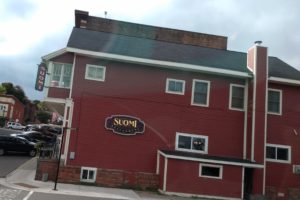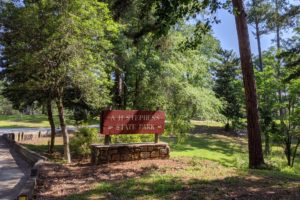As Carson Valley grew in the mid- to late 1800s, places, people, inventions, and mustangs grew in their importance. The oldest town in the valley is Genoa, first known as Mormon Station. The Genoa Bar is the oldest “thirst parlor” in the state, founded in 1853, and is probably the best known of all the old buildings in town.



inside the bar the walls are 
covered with dusty items (achoo!)

As we said, Genoa was originally known as Mormon Station because the Mormons were leading the way to colonize new territories. They opened the trading store to sell whatever they emigrants needed for their trip over the Sierras. Mormon Station also had a blacksmith shop, livery stable, and nearby flour and saw mills.
Slowly people decided to stay put and put down roots in the fertile area. In 1855, Orson Hyde was sent by Governor Brigham Young to be the area’s probate judge. Since he was more of a world traveler than a judge, he changed the area’s name to Genoa since Genoa, Italy, was his favorite overseas city, and Genoa became the county seat.
More Mormons settled into the area until 1857 when they were all called back to defend Salt Lake from the advancing U.S. Army. A whole other story there, right?
Starbucks and favorite pizza place!
We love hanging out at Starbucks to work on the blog and talk with people. This Starbucks was next to our favorite California pizza place—Round Table!

The Basque

Basques, from the Pyrenees Mountains of southern France and northern Spain, came to the United States during the 1848 gold rush and then moved into Nevada, Utah, and Idaho to become sheepherders, not because they knew what they were doing but because they were able to keep lambs alive and fatten them up while losing few of the adult herd.
They lived simply and isolated, only seeing their bosses once or twice a year during lambing and shearing.

Soon they bought their own ranches and herds of sheep. Others went into the hotel business since this was a comfortable world for them. Today they are well respected and valued in the community.


I had remembered hearing about the Basque in this region and how good their food was. So . . . we went to J.T. Basque Bar & Dining Room in Gardnerville for lunch and had the best Basque food ever!






Snowshoe Thompson – a hero of the Sierras

Originally from Norway, he met the need of people on the east side of the Sierra being cut off from the outside worlds during winter storms by carrying mail from Placerville (gold country) to Genoa He made his long skies (called them snowshoes) like his father had and adapted the snow county survival techniques he had been taught as a young man.

He made his first trip across the mountains in January 1856 on an uncharted route buried in snow. Usually the trip took 3 days going and 2 days returning. Twice a month for 20 years he carried mail without ever being paid.

He made his 10-foot skies from oak timber. The trip between Placerville and Genoa was 90 miles! He also carried ore samples, medicines, and a newspaper during his journeys.

His knowledge of the treacherous Sierra helped him travel through blizzards in the dead of night without ever getting lost.


Dr. Eliza Cook was the first female doctor in Nevada. Bet she could have taught Dr. Quinn, Medicine Woman (TV show in the 1990s) a thing or two (or visa versa).



Fred Dressler, now (1996) and then


At the casino where we’re staying, they had a prime rib special for $9 on Monday night, so of course we went and sat next to some nice folks to talk with while eating.

local drygoods store


local tool inventions for business and the home




Mustangs
Mustangs originated here in North America, but the original controversy is over whether they survived the Ice Age or were re-introduced by the Conquistadors in the late 1400s to early 1500s. This controversy leads into the controversy today.




In the late 1800s, America had around 2M free-roaming horses. Since 1900, the population has been drastically reduced and wild horses have disappeared from 6 states. More than half of the remaining 25,000 are in Nevada.
These wild horses had been a resource for pet food, and the practice was called “mustanging.” The 1961 movie filmed in Nevada, “The Misfits,” highlighted the practice of chasing horses down with mechanized vehicles and airplanes, trapping them in pens, and poisoning them. These practices led to the first federal horse protection law in 1959.

The Bureau of Land Management (BLM) now controls the mustang population through a capture program to control competition with cattle and other wild animals on range land. These horses can be “adopted” by individuals for a small fee, and they are still protected from being sold as horse meat.


Another law in 1971 for wild horses and burros (Spanish for mules).

Some famous mustangs hang out with the Marine Corps Mounted Color Guard.


Now we’re on to a museum at the Mormon Station in Genoa.




